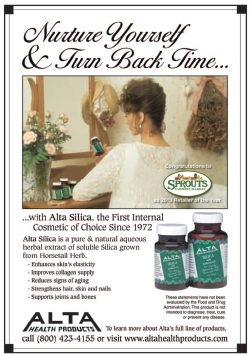Stocking up on feminine hygiene options is not only comforting to women looking to make the best choices for their health during their cycles, but it is also an important step in helping your customers make “that week” feel just like any other.
Take Care with Cotton
Your customers care about what they put into their bodies, and tampons are no exception. Synthetic tampons are often made with a cotton/rayon blend, can be bleached with chlorine to sterilize the fibers and carry the risk of containing dioxins (1). Organic cotton tampons eliminate any worries about possibly absorbing something harmful or unnatural by leaving out the chemicals, synthetic ingredients, additives and chlorine bleach. Using organically grown cotton for tampons also removes any risk of absorption of pesticides, fertilizers and fungicides that could be leftover from the growth and production of non-organically grown cotton, or artificially added fragrances and dyes (2).
Don’t Refuse to Reuse
For women concerned about reducing their environmental impact on landfills, there are a few greener options, starting with pads. Branded, reusable pads made from layers of absorbent cloth come in the same thicknesses for light to heavy flows as disposables do and are made to be easily cleaned in a washing machine. Keep a selection of various lengths and thicknesses available as well as a range of color and pattern options as many companies offer everything from plain white to simple dark colors to colorful cartoon characters printed on the pads!
Another option is a reusable menstrual cup. The user inserts the cup,  shaped like a bell and often made of non-pigmented silicone, and takes it out once full to be washed and reinserted. One cup can typically last up to a year of use, depending on cleaning, and can be worn for up to 12 hours before typically needing to be washed (3). Disposable cups are also available where one cup is used throughout then thrown away after one cycle (4).
shaped like a bell and often made of non-pigmented silicone, and takes it out once full to be washed and reinserted. One cup can typically last up to a year of use, depending on cleaning, and can be worn for up to 12 hours before typically needing to be washed (3). Disposable cups are also available where one cup is used throughout then thrown away after one cycle (4).
Tampons, pads and reusables are the important basics for a well-stocked feminine hygiene section, but your female customers may need something to get them through their monthly visit from Aunt Flo (and, no, we don’t mean chocolates and ice cream).
(Do) Rub It In
Consider including related products that may help your female customers get through menstrual pain. Sometimes, this pain amounts to nothing more than a mild annoyance, but for some, it becomes an onslaught of debilitating agony (5).
Some women are uncomfortable with taking ibuprofen, over-the-counter branded, cramp-relieving pills that contain little else besides caffeine or pain relievers, and instead become resigned to the pain as just something that they must fight through every month. Because of this, it’s hard for many to concentrate on classwork or job duties, making painful menstrual cramps one of the top reasons for absences from school for teens and missed days of work for young professional women (5).
One avenue for natural pain relief can come from essential oils. A double-blind study from the Journal of Obstetrics and Gynecology Research tested the analgesic effects of essential oils on women suffering from cramps (normal/average) who had rated their average pain over five points out of 10, over the course of one menstrual cycle (6).
A blend of aromatic essential oils of lavender, clary sage and marjoram at a 2:1:1 ratio, mixed with an unscented cream was given to one group, while another used a synthetic fragrance; all were instructed to massage the mixtures into their abdomens from the end of one menstrual cycle into the next. After their next cycle, participants were asked again to rate their pain, and the women in the essential oils group rated theirs significantly lower than when they had not used the cream in previous cycles (6).
Researchers concluded that the mixture contains four analgesic components (linalyl acetate, linalool, eucalyptol and beta-caryophyllene) that may give topical pain relief to women suffering from typical menstrual cramping (6). In addition to the oils used in this study, borage, evening primrose and black currant seed oils can also be found in topical products intended to reduce cramping.
It’s important to remind your customers that if their cramping is consistently incapacitating, they should seek the advice of a health care professional as they could be suffering from something more serious, such as pelvic inflammatory disorder or a sexually transmitted infection (5). WF
References
1. Epigee, “Conventional Wisdom: Tampons and Pads,” www.epigee.org/menstruation_products.html, accessed May 23, 2013.
2. Natracare, “Why Natracare Tampons,” www.natracare.com/p263/en-GB/Why-Natracare/why-natracare-tampons.aspx, accessed May 23, 2013.
3. DivaCup, “Your First Questions,” http://divacup.com/how-it-works/your-first-questions, accessed May 23, 2013.
4. Softcup, “FAQ,” http://softcup.com/how/faqs, accessed May 23, 2013.
5. MedlinePlus, “Painful Menstrual Periods,” www.nlm.nih.gov/medlineplus/ency/article/003150.htm, accessed 23 May 2013.
6. M.C. Ou, et al., “Pain Relief Assessment by Aromatic Essential Oil Massage on Outpatients with Primary Dysmenorrhea: A Randomized, Double-Blind Clinical Trial,” J. Obstet. Gynecol. Res., May 2012, online Mar. 28 2012, www.ncbi.nlm.nih.gov/pubmed/22435409, accessed May 23, 2013.
Published in WholeFoods Magazine, July 2013









